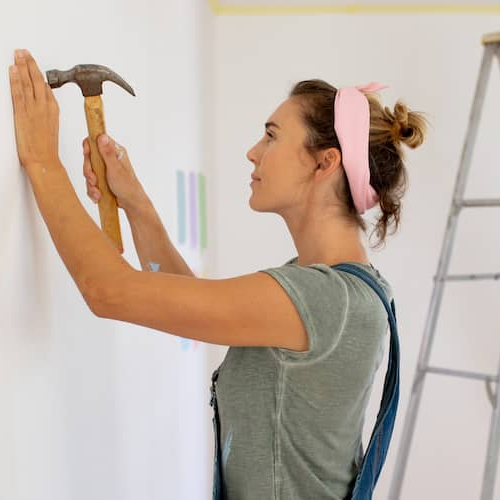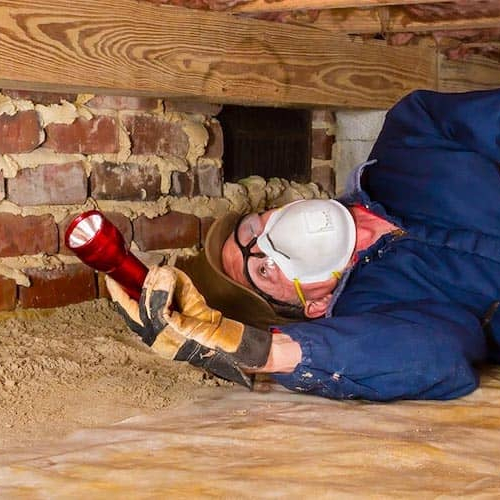Your guide to blue tape walk-throughs
Contributed by Sarah Henseler
Jul 29, 2025
•5-minute read

Building or buying a new-construction home involves many important decisions. As you near the final stages of the process, one of the last steps is the blue tape walk-through. This inspection allows you to walk through the home with the builder and mark any items that need to be corrected before you close.
The blue tape walk-through gives you the opportunity to confirm the home is built as agreed. It helps ensure the home is ready for move-in day and that all construction and finish work has been completed. If something needs to be fixed, it can be marked with blue painter’s tape and added to the builder’s punch list. The builder will then complete all necessary repairs before closing.
In this guide, we explain how this walk-through works, what to bring, and what to look for in each room of your new home.
What is a blue tape walk-through?
A blue tape walk-through is an inspection that takes place after the construction of your new home is complete. This usually occurs a few weeks before closing. The purpose of the walk-through is to identify any issues that need to be corrected while the builder is still responsible.
The term “blue tape” refers to the painter’s tape used to mark areas of concern. These can include cosmetic flaws like chipped paint or scuffed floors, as well as functional issues like sticking doors or loose handrails. Each tape mark becomes part of a punch list the builder uses to make final repairs.
The walk-through is completed with a representative from the builder’s team. Your real estate agent can also attend. Their support helps document concerns and communicate with the builder.
The goal of this inspection is to confirm the home has been built correctly and meets the standards in your purchase agreement. This process is similar to a home inspection on an existing home, but focuses on new materials, systems, and finishes rather than wear and tear.
Bring tools that help you perform a detailed inspection. A flashlight, level, measuring tape, and camera or phone can help you inspect corners, check surfaces, and document issues.
If something is missed during the walk-through, a home warranty may offer future protection. Many new-construction homes include builder warranties that cover structural elements, systems, and appliances for a limited time. To learn more about the full process, visit our guide on buying a new-construction home.
Blue tape vs. final walk-throughs
The blue tape walk-through and final walk-through are both part of the closing process, but they serve different purposes.
The blue tape walk-through is specific to newly constructed homes. It happens first and gives you the chance to walk through with the builder, inspect the home, and flag any issues. These concerns are marked with blue tape and documented.
The final walk-through occurs just before closing. At this stage, you confirm that all repairs from the blue tape inspection have been completed. This step also confirms that the home is clean, functional, and ready for move-in.
Buyers of previously owned homes do not have a blue tape walk-through but do complete a final walk-through to ensure the property is in the same condition as agreed.
The blue tape walk-through is an important step that protects your investment. If significant issues are not resolved, you may be able to delay or cancel closing, depending on your purchase contract. Learn more in our final walk-through checklist.
New construction walk-through checklist: Things to look for on blue tape day
This walk-through is your opportunity to assess every space in your home. As you move from room to room, use blue painter’s tape to mark anything that needs repair, adjustment, or finishing. These markings form the builder’s punch list.
Safety hazards
Focus first on safety issues. Look for signs of pests in hidden areas like under sinks and behind appliances. Watch for mold growth or moisture, which may indicate plumbing problems. Check that handrails and banisters are secure.
Inspect gutters for clogs or detachment. Watch for visible water stains or soft drywall, which may signal leaks. Confirm the stairs are level and solid. Note cracks or bowing in the foundation, and consider professional testing for radon or carbon monoxide if required. For more detail, review our guide on pest inspections.
Window quality
Windows should be fully functional and well sealed. Check that caulking is even and complete. Glass should be free of cracks. Frames should not show signs of rot or damage. Screens should fit securely with no tears.
Look for weep holes, which are small drainage openings at the base of exterior window frames. These prevent water from collecting inside the window structure. Confirm that windows open easily. This feature supports both ventilation and emergency access.
Door and drawer mobility
Open and close every door and drawer in the home. Doors should not stick, squeak, or sag. They should align with the frame and latch securely. Check for any damage around the frame.
Test all interior and closet doors, as well as the front and garage doors. Garage door sensors should respond correctly and provide safety when closing. The front door, as your home’s main entry point, should be solid, secure, and fully functional.
Appliance and house system functionality
New-construction homes include new appliances. Check the refrigerator, dishwasher, washer, dryer, and any included freezers to confirm they work properly and are installed to code.
Test the HVAC system, plumbing, and electrical components. Run the heat and air conditioning. Turn on lights, test outlets, and check that plumbing fixtures do not leak. Breaker boxes and shut-off valves should be clearly labeled and easy to access.
Many systems and appliances are covered by warranties. Review the documentation and keep it organized. Use blue tape to mark any malfunctions or missing parts so the builder can correct them before closing.
Minor cosmetic issues
Small, cosmetic issues affect the visual appearance and value of the home. Look for scratches, paint flaws, gaps in trim, or dents in cabinets or walls.
Mark chipped paint, uneven caulking, flooring seams, or any visible nail holes. These issues are typically easy to fix but should be documented during the walk-through. Being thorough now helps ensure the home meets your expectations on move-in day.
What happens after the walk-through?
Once your inspection is complete, the builder will collect the punch list and outline a timeline for completing the work. If you are working with a real estate agent, they can help monitor the repair progress and follow up with the builder.
The builder’s team should complete all listed items before closing. Communication during this time is key. Ask for updates and confirm that expectations are understood by both sides.
Before closing, the final walk-through provides a chance to confirm that all items have been resolved. Bring your original list and check each correction. This step ensures the home is move-in ready and helps avoid surprises after you take ownership.
The bottom line: Blue tape walk-throughs help get your new house move-in ready
The blue tape walk-through is an essential step in the process of buying a newly built home. It gives you a chance to evaluate the finished product, address any issues, and confirm that everything has been completed according to plan.
This inspection helps identify both major and minor problems. From structural concerns to cosmetic flaws, every detail counts. Marking them early allows the builder time to fix the issues and helps you move forward with confidence.
For help preparing for your final review of the home, visit our final walk-through checklist. Talk with one of our Home Loan Experts to help navigate the ways you’ll pay for your new home.
Christian Byers
Christian Byers is a freelance writer and editor with experience covering diverse topics. He has a B.S. in Journalism and a B.A. in Communications from Eastern Michigan University. His experience as a writer and editor includes publications such as The Eastern Echo, Rocket Central, and Woodward Sports Network.
Related resources

7-minute read
Cheapest ways to build a house: 12 tips for affordable home building
Building a home can be a viable option for buyers in a competitive market, but expenses can add up quickly. Discover the cheapest ways to build a house.
Read more

6-minute read
What is a 4-point inspection?
A 4-point inspection looks at a property's four major systems. Learn more about what a 4-point inspection is and why you may need one before purchasing a home.
Read more

10-minute read
Checklist for buying your first house
The process of buying a home can be complicated, especially for first-time buyers. Make it simpler with this house buying checklist.
Read more